The model Work Health and Safety (WHS) laws require employers* to take care of the health and safety of their workers and others at the workplace. This includes:
- Providing and maintaining a work environment that is without risk to health and safety; and
- Adequate facilities for workers in carrying out their work.
As an employer, you must identify risks at the workplace, and where possible eliminate or minimise those risks.
FIFO and DIDO workers are at risk of exposure to COVID-19
FIFO and DIDO workers are essential to keeping key sectors of the Australian economy operating, such as mining. The transient nature of FIFO and DIDO workforces, combined with the fact that these workers must travel, work, eat, and reside in close proximity to each other, increases the risk of exposure to COVID-19. Due to the nature of the work, most of these workers cannot work from home.
While it may be more difficult for your workplace than for other workplaces, you must do everything reasonably practicable to keep these workers a safe distance apart.
You must implement control measures to minimise the spread of COVID-19 and ensure that other measures to address well known work health and safety risks continue to be implemented. This is the case even if implementing control measures result in delays to your production.
Managing the risks of exposure to COVID-19
Physical distancing
Physical distancing may be more challenging for your workplace than for some others, but it is a key measure to minimise the spread of COVID-19.
- Limit physical interactions between workers.
- Workers who can work from home (e.g. office staff) should work from home.
- Review tasks and processes that usually require close interaction and identify ways to modify these to increase physical distancing between workers where practical and safe to do so.
- Postpone non-essential gatherings or training.
- For essential gatherings, conduct in spaces that enable workers to keep the required physical distance of at least 1.5 metres, ideally outdoor spaces.
- Conduct briefings or training through online means, such as apps.
- Split workers’ shifts to reduce the number of workers onsite at any given time.
- Allow additional time between shifts to limit staff interaction and enable time for cleaning.
- Split dining times. Spread out furniture in dining facilities. Consider allowing workers to take their meals away to consume in their rooms.
- Split travel to site, whether on planes, buses or in vehicles.
- Split movement of persons on site, e.g. on buses or in vehicles, or in lifts.
- Cancel unnecessary recreational activities on site, eg sport.
- Close communal facilities and spaces (e.g. gyms), consistent with general public health advice. Some communal spaces may be able to be modified to enable workers to keep the required physical distance of at least 1.5 metres.
- Use methods such as mobile phone or radio to communicate.
- Limit worker numbers on site where possible.
- Reduce the number of tasks to be completed each day.
- Postpone non-essential work.
- Create specific walkways through the site to maintain physical separation.
- Consider if plant can be used to reduce the number of workers interacting.
- Place signage about physical distancing around the workplace.
Nominate responsible persons to make sure your workers are following the rules for physical distancing.
If physical distancing measures introduce new health and safety risks (e.g. because they impact communication), you need to manage those risks too.
“As an employer, you must identify risks at the workplace, and where possible eliminate or minimise those risks.”
Health checks & quarantine
The health of your workers should be checked for key symptoms of COVID-19, such as fever.
- Direct all workers (whether they are at the workplace or not) to report to you if:
- they are experiencing any symptoms
- they have been, or have potentially been, exposed to a person who has been diagnosed with COVID-19 or is suspected to have COVID-19 (even if the person who is suspected to have COVID-19 has not yet been tested), or
- they have undertaken, or are planning to undertake, any travel.
- Encourage workers to report if they observe another worker is displaying any symptoms.
- Check the temperature of your workers regularly, including before travel to the workplace where possible (e.g. before workers board their flight), and at each roster change.
- Consider obtaining some COVID-19 testing kits, if possible.
- Prohibit workers travelling and working if they are displaying symptoms.
- Prohibit workers who have contracted COVID-19 from returning to the workplace until they provide evidence they are clear of the virus.
- Designate areas for quarantine and medical treatment of workers displaying symptoms. Consider evacuating such workers from the site altogether.
- Designate areas for quarantine of workers who report being a close contact of a diagnosed case of COVID-19.
Control travel
Travel and interaction during travel should be limited and controlled as much as possible:
- Split travel to site, whether on planes, buses or in vehicles.
- Assist workers to temporarily relocate close to the workplace, to eliminate their need to travel during this period.
- Use charter flights for your FIFO workers if possible.
- Split movement of persons on site, e.g. on buses or in vehicles, or in lifts.
- Prohibit workers travelling to local communities during their time off.
- Assess the risk of workers travelling to and from the workplace if they report to you:
- they are experiencing any symptoms
- they have been, or have potentially been, exposed to a person who has been diagnosed with COVID-19 or is suspected to have COVID-19 (even if the person who is suspected to have COVID-19 has not yet been tested), or
- they have undertaken any travel.
Hygiene
Environmental cleaning
The amount of time COVID-19 survives on objects and surfaces will vary. Environmental cleaning is one way to remove COVID-19 particles.
Usual cleaning schedules will need to be increased.
- Frequently touched surfaces, including handrails and doors, should be cleaned frequently using appropriate detergent or disinfectant solutions.
- Accommodation, kitchens, dining facilities, common areas, change rooms, toilets, showers, linen, drink fountains and vending machines, should be cleaned industrially and the frequency of this cleaning should increase.
Also consider reducing the number of touch points for workers. For example, leaving access doors open, where appropriate.
Workers should be provided with cleaning agents and trained to clean down plant or equipment immediately after use. Transport vehicles should also be cleaned frequently.
To minimise the risk of exposure to COVID-19 the person cleaning should wear gloves and use alcohol-based hand sanitiser before and after wearing gloves.
Gloves and hand sanitiser should be made available throughout the workplace.
You should conduct regular audits to ensure workplace cleaning and hygiene requirements are being met.
See the Department of Health information sheet on Environmental cleaning and disinfection-principles for COVID-19 for further information.
Worker hygiene
Workers should be required to practice good hygiene. This includes:
- covering coughs and sneezes with an elbow or a tissue
- disposing of tissues properly
- washing hands often with soap and water for at least 20 seconds, including before and after eating and after going to the toilet
- using alcohol-based hand sanitisers
- cleaning and disinfecting surfaces
- washing body, hair (including facial hair) and clothes thoroughly every day
- staying more than 1.5 metres away from others, and
- reporting and staying home if experiencing any symptoms.
In addition, to prevent the spread of COVID-19, workers should also:
- avoid touching their face
- avoid handshakes or any other close physical contact
- refrain from spitting at all times, and
- put cigarette butts in the bin.
Washroom facilities should have adequate supplies for good hygiene, such as adequate supply of soap, water and toilet paper. Washroom facilities must be kept clean, properly stocked and in good working order. Workplaces should also be well stocked with alcohol-based hand sanitiser.
To enhance worker hygiene standards, you should also:
- adequately delineate between work and common areas. This could include reminding workers (with posters or through training) to their hands with soap and water for at least 20 seconds, or sanitise their hands with alcohol-based hand sanitiser, before entering and exiting a common area.
- inform workers of workplace etiquette and standards that are expected when utilising these common areas (cleaning up after yourself, placing rubbish in bins provided, avoiding putting items such as phones on meal surfaces etc.)
“Provide workers with a point of contact to discuss their concerns, and access to support services, including employee assistance programs.”
Deliveries and contractors attending the workplace
Non-essential visits to the workplace should be cancelled or postponed.
Deliveries and other contractors who need to attend the workplace should be given clear instructions of your requirements while they are on site.
Minimise the number of workers attending to deliveries and contractors as much as possible. Make alcohol-based hand sanitiser available for workers after physically handling deliveries.
Direct visiting truck drivers to remain in vehicles and to use contactless methods such as mobile phones to communicate with your workers wherever possible.
Use, and ask deliveries and contractors to use, electronic paper work where possible, to minimise physical interaction. Where possible, set up alternatives to requiring signatures. For instance, see whether a confirmation email or a photo of the loaded or unloaded goods can be accepted as proof of delivery or collection (as applicable).
To assist you in assessing the level of risk posed by visitors, consider requesting information from regular deliveries and contractors about what measures they have in place to manage the risks of COVID-19 for their workers.
Keep workers informed
You should provide all workers information about the risks of exposure to COVID-19. Where required, workers should be trained in infection control.
The Australian Government Department of Health has a range of posters and other resources aimed at educating the public about COVID-19.
Consultation and communicating with workers
You must consult with workers on health and safety matters relating to COVID-19. Allow workers to express views before you make decisions.
You must also consult with other duty holders working on site.
Workers are most likely to know about the risks of their work. Involving them will help build worker commitment to this process and any changes.
The model Code of Practice: Work health and safety consultation, cooperation and coordination can give you more information about your duties to consult.
Communicate clearly with workers about control measures. Provide clear direction and guidance about what is expected of workers.
Workers should know:
- when to stay away from the workplace
- what action to take if they become unwell
- what symptoms to be concerned about.
Remind workers they have a duty to take reasonable care for their own health and safety and to not adversely affect the health and safety of others.
Provide workers with a point of contact to discuss their concerns, and access to support services, including employee assistance programs.
Interstate workers
Some states and territories have largely closed their borders, requiring people arriving from interstate to self-quarantine for at least 14 days. There are some exemptions, including for FIFO and DIDO workers, but these may vary from state to state.
You should stay up to date on the latest travel restrictions and requirements from the Commonwealth, state and territory governments and provide that information to your workers.














While the content of the article is good, It should be pointed out that workplaces on land subject to mining tenure are not subject to model Work Health and Safety (WHS) laws.
For example, in Queensland coal mining is subject to the Coal Mining Safety and Health Act and Regs and all other mining (metalliferous) is subject to the Mining and Quarrying Safety and Health Act.
These Acts are not in alignment with model Work Health and Safety laws. So referencing requirements of WHS laws is not appropriate.